Myofascial Release - Brisbane MSK Clinic
What is Myofascial Release?
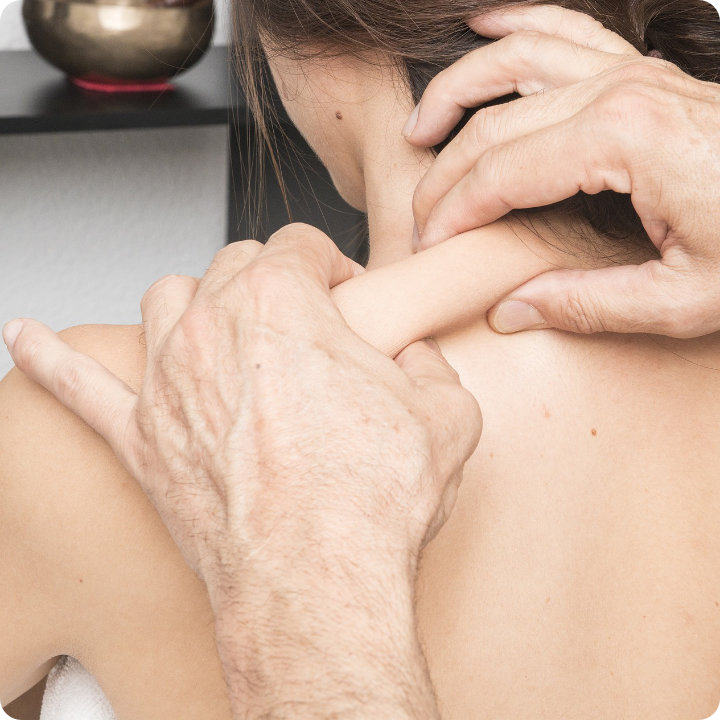
Myofascial Release is a manual therapy for increasing mobility and relieving myofascial pain by applying fascial releases to soft tissue structures. There are many different forms of myofascial release techniques, which work differently, are applied differently and feel different during application. What one feels as a patient largely depends on the therapist's experience, knowledge, training, and technique application. Hence, a fascial release treatment can range from mild discomfort to excruciating pain, as Terry, the author, knows all too well. He once attended a soft tissue therapy conference the day after running a half-marathon and, unfortunately, was volunteered to be the client for a fascial release therapy demonstration. The technique involved applying a lot of pressure via the blade of a forearm up the side of his legs and ITB, which proved excruciating, and it was not a technique he would use in the same circumstances.
The medical doctor and founder of Osteopathic Medicine, Andrew Still, has been credited with pioneering a range fascial releasing techniques. However, there have been other well-known contributions to MFR techniques, notably by Ida Rolf (Rolfing). The specific term Myofascial Release came about much later in the 1960s through the work of an Osteopath "Robert Ward" and Physiotherapist "John Barnes". Muscles, fascia and the fascial network play a large part in the theory behind the method and its development. Myofascial therapy aims to identify and treat adhesions or restrictions within soft tissue structures and fascia to free movement and reduce pain.
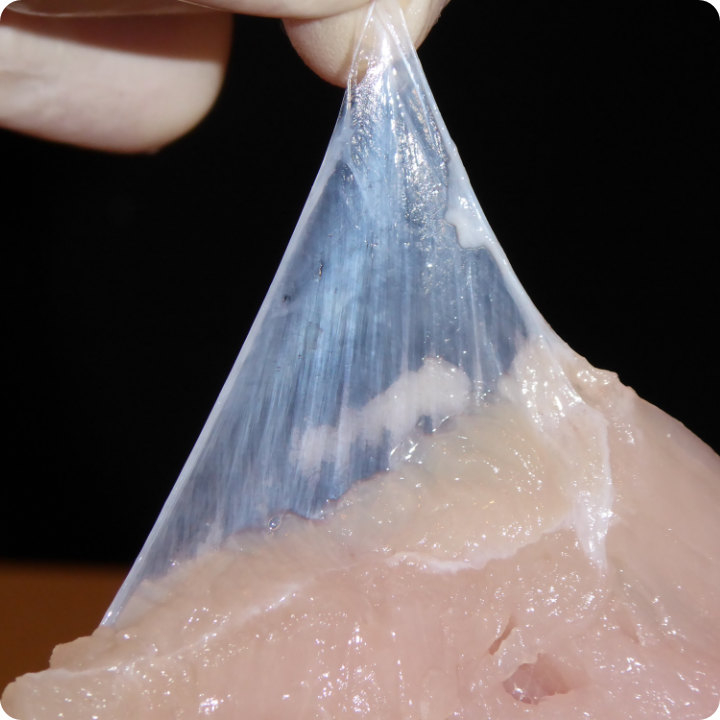
The image on the left is of a piece of chicken breast, and the shiny translucent material is fascia separating the tenderloin from the breast. Further details on fascia and myofascial pain are available by following the link. Myofascial Trigger Points (MTrPs) are also inseparable from myofascial release and myofascial pain. Some techniques look to identify and directly treat myofascial trigger points, which have relevance to chronic pain conditions. In contrast, fascial release methods look to treat trigger points (TrPs) indirectly. Hence, myofascial release is far more than just trigger point therapy and, in essence, is a toolbox of techniques and methods. Myofascial Release techniques are just one of many treatment methods available at the Brisbane MSK Therapy Chronic Pain Clinic in (Morningside).
Fascial releasing techniques are usually performed very specifically and do not feel or resemble a typical relaxing massage. Any soft tissue therapy or massage will impact fascia to some extent. Hence, there are some similarities yet many differences between the therapy methods. Fascial releasing techniques are typically very specific and involve the therapist applying techniques in different planes, combining sustained compressive, tractional and rotational forces. Massage therapy tends to be less precise, with more vigorous tissue movements or gentle stroking-type massage strokes. Although anybody can call themselves a massage therapist or myofascial release therapist in most countries, there are differences between professionals trained and registered with professional associations. Massage therapists often perform a whole-body treatment routine and have limited training in assessment, diagnostic testing and musculoskeletal conditions. It is possible to use techniques from base-level massage therapy to treat fascial restrictions to some extent, such as petrissage, frictions and skin rolling , which may explain the phrase myofascial massage. However, effective treatment involves more than just applying a technique to something of unknown origin and may even be contraindicated or unsafe. Training in fascial releasing techniques tends to occur on more advanced courses and often with other prerequisite knowledge.
Deep tissue massage may involve fascial releasing techniques from sports massage therapy, such as deep frictions or muscle stripping. The Active Release Technique (ART) ®is, in essence, a form of sports massage muscle-stripping with active muscle movement and a set protocol. Deep tissue massage refers to the level or layer of tissues treated, so deeper layers rather than superficial, nearer the surface.
Myofascial Release in much more detail
Myofascial Trigger Points and breaking down fascia
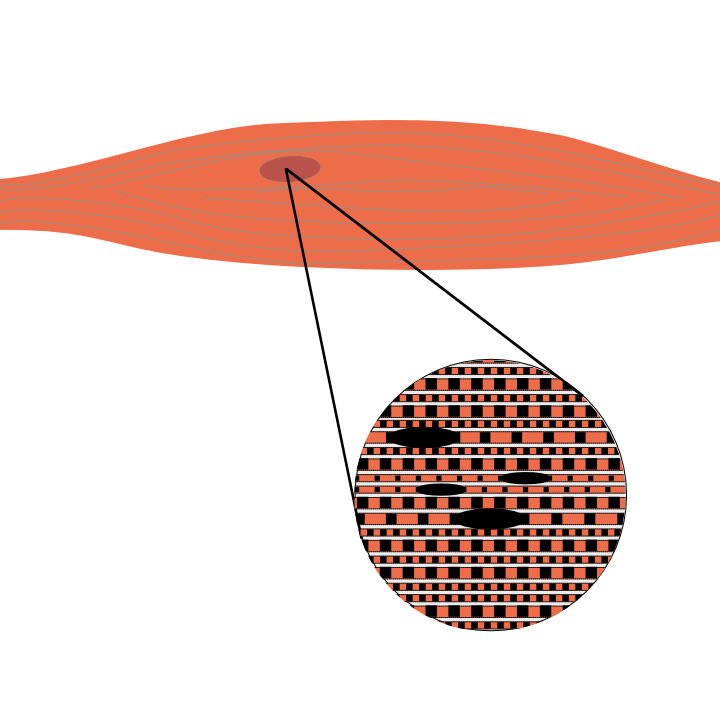
Many massage therapists and regulated professionals speak of breaking up scar tissue and tight fascia. However, myofascial release is more about releasing "stuck" tissues or Myofascial Trigger Point's (MTrP's) or TrP's for short than breaking anything down. In brief, trigger points appear as nodules within soft tissues and are hyperirritable taut bands of skeletal muscle, which can cause fascial pain. Some fascial releasing methods look to locate and treat TrPs, and other techniques work more broadly. Anatomy education tends to use the concept of layers when learning about soft tissues and for ease of understanding going from superficial to deep. However, all tissues are interconnected (biotensegrity) and so not layers per se, with tissues gliding over each other to enable pain-free unrestricted movement. Fascia can become "sticky" for many reasons, making it harder for tissues to glide over each other, thus restricting mobility. Releasing such fascial restrictions frees these areas of stickiness and enables normal pain-free movement, though the aim is not to break up the fascia. Actual research relating to the field of fascia is a relatively new area of study (a few decades).
Evidence informed practice and fascial research
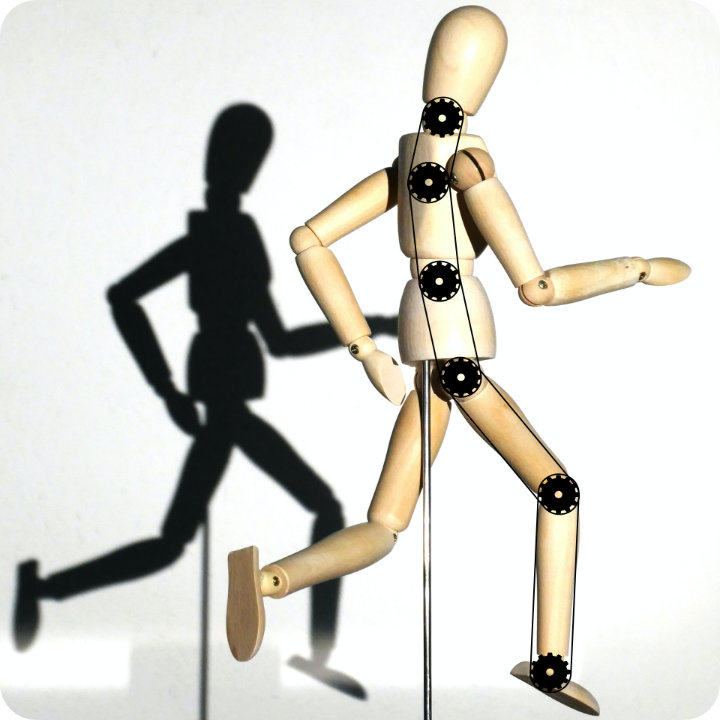
Evidence based on research would suggest that releasing fascia or, more specifically, myofascial trigger points positively affects movement and reduces myofascial pain. Some fascial releasing techniques have a greater weight of evidenced-based research, such as dry needling [1-23] and ischemic compression [24-30], than other methods such as Gua Sha [31-33]. Most allied health professionals within the MSK field learn varying levels of soft tissue therapy techniques. Equally, Allied Health Professionals must complete a research component as part of their higher education qualifications, though this research tends to be profession-specific. Allied health professionals may or may not learn fascial releasing methods as part of their higher education training, which impacts the possible research base. Some professionals will undertake further training in fascial techniques after qualifying in their chosen profession. Hence, there can be gaps in the research base due to research limitations. However, just because some MFR techniques may not have conclusive research regarding the efficacy of such methods does not mean they do not work. Clinical judgement based on training, education, accumulated experience and research covering related areas is all highly relevant. There is some fascinating research related to the roles that fascia plays within the human body, but a vast amount is still not understood. Most research on the roles of fascia stems from anatomists and is under the umbrella of general medicine, and is well-funded.
Our principal Musculoskeletal therapist has used many fascial releasing techniques during his 16 years in practice and found them highly effective. He has also found that such methods can produce fast, long-lasting and even sometimes profound results in Chronic pain cases. As an ex-veteran and somebody who has been highly active, our principal became interested in MFR to treat some historical injuries impacting his performance. The general medicine approach was not resolving these injuries (see the ankle injury article for further details). The process involved a lot of self-experimentation and additional training in many methods.
What are the benefits of releasing fascia?
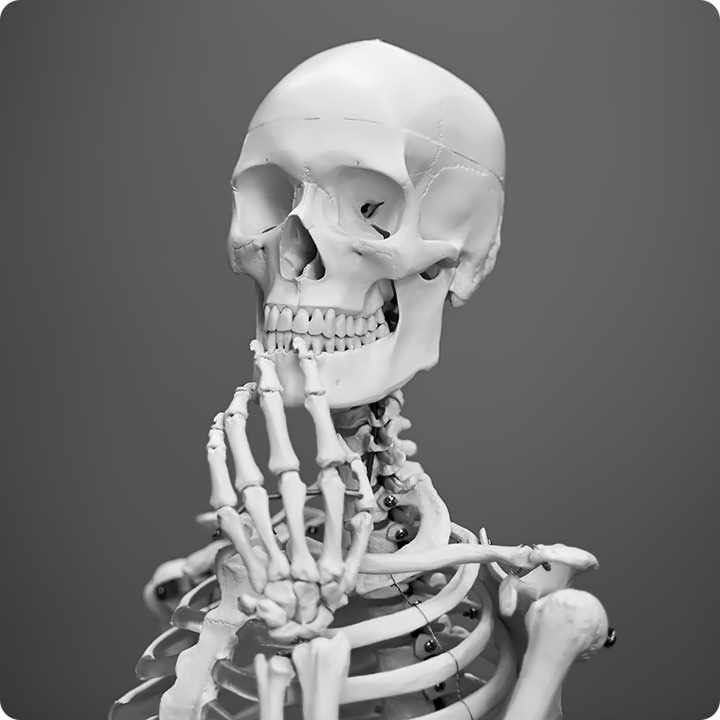
There are many methods to treat fascial restrictions within tissues effectively, and they work in slightly different ways. Knowing when or not to apply a specific method will depend on clinical judgement, training, education and practitioner experience. With the correct knowledge and technique application, it is possible to produce some fast-acting and long-lasting results for patients. One of the best aspects of some fascial techniques is the ability to apply such methods passively or actively. Purely passively treating tissues tends not to utilise tissues as one would naturally use them when performing normal activities. Hence, everything may seem fine during treatment but not later while performing activities. Unlike normal prescriptive exercises (stretches), many fascial releasing techniques aim to treat virtually the entirety of the tissues or structures suspected of causing the patient's symptoms. Self-myofascial release (SMFR) can also prove helpful in some cases, though there are limits on what one can achieve (see the SMFR section and articles later). Sometimes, it may not be effective or make things worse.
It is possible to perform fascial releasing techniques like Neuromuscular Therapy (NMT), Soft Tissue Release (STR), Muscle Energy Techniques (MET), and Positional Release through clothing. Many of these methods do not require direct skin contact, the need to undress, or the use of massage lotion. Hence, one can avoid that oily feeling after treatment and when getting reclothed. Other techniques such as Gua Sha, IASTM and other forms of methods require direct skin contact and massage lotion. STR can work extremely well with direct or indirect skin contact and with or without lotion. Trigger Point Needling is another method of treating fascial pain requiring direct skin contact.
Treatments aim to treat myofascial pain, restricted mobility and dysfunctional tissues, including fascia, muscles, tendons and ligaments. Such methods are well suited to treating acute and chronic pain conditions (see article). There are a variety of work and sports injuries that can respond well to treatment. Including more complicated conditions including neck pain, headaches, bursitis, repetitive strain injury (RSI) and more.
There are various reasons for fascia becoming dysfunctional, resulting in restricted mobility, muscle spams, cramps, headaches, pain or recurring injuries. Changes within the fascial network can occur due to physical trauma, hydration levels, habits and activities, diet, medical conditions and other factors. Unresolved injuries often lead to further and seemingly unrelated injuries or problems. Stretching and self-help have limitations, though they are good as part of an injury prevention strategy and so are generally a good idea. It can be helpful to see somebody specialising in fascial techniques when other methods or the traditional medical approach are ineffective.
As with many types of treatment, the frequency and need for any soft tissue therapy depend on many factors, such as previous injury history, medical conditions, hobbies, interests, activities and other aspects of health. Prevention can make a huge difference, as can changing contributory factors causing symptoms. Sometimes, treatment might be weekly, alongside prescriptive exercises, for a few weeks and then more spaced out. In other cases, treatment might be every month or longer. Individual patient motivation can play a huge part, as can following professional guidance. Aftercare advice tends to be as important as physical treatment and enhances the effects of treatment if followed correctly. Hence, people must be honest about whether they follow such advice, as it greatly impacts positive treatment outcomes. Patient's can choose to take a passive or active part in their treatment process. Pharmaceutical pain relieving products rely on the consumer taking a passive treatment approach. Such an approach is simple and only involves consumers buying pills, pain relieving gel etc., to mask the pain without addressing the reason for symptoms. Bad actors within the MSK Therapy profession also rely on consumers taking a passive approach to treatment and depending purely on the therapist, tying the consumer to prolonged treatment. An active approach is patient-centred, requires work on the part of the therapist and patient and produces the best and fastest results.
Myofascial Releasing Techniques
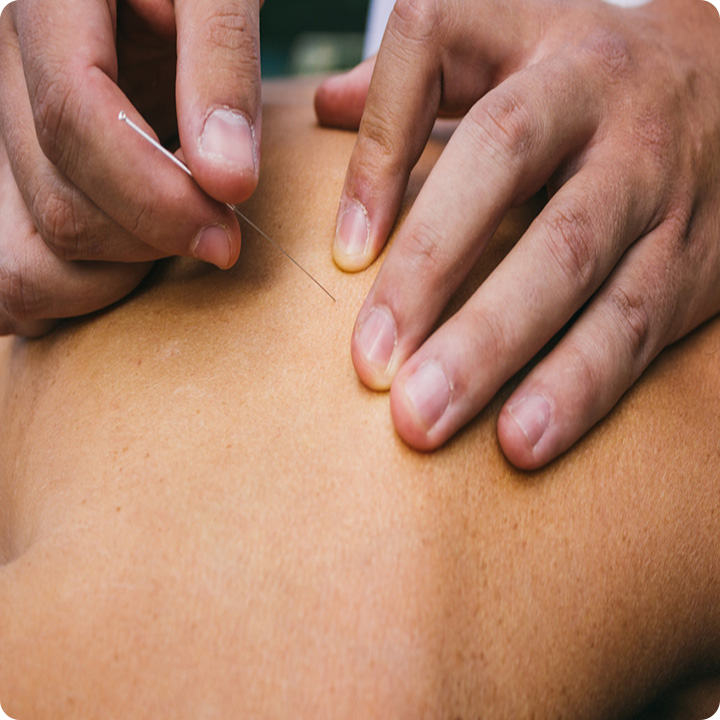
The umbrella term myofascial release covers many methods for assessing, treating and performing releases. The "stripping" technique in sports massage is a deep tissue massage technique and a basic form of MFR. The method is performed slowly along the length of muscles under treatment, using the therapist's forearm, elbow, thenar eminence (part of the hand), or fingers. Many other types of MFR have a similar basis, though variations in process, application and naming of method exist (see later).
Treatment may also use a style that works in a "static" or "dynamic" way. Typically, "static" releases would involve the practitioner assessing and treating tissues with the patient staying still "static". Dynamically, applied releases involve the patient moving the tissues under assessment/treatment, with or without the therapist applying a technique with movement. Therapists can also treat tissues in either weight-bearing or non-weight-bearing positions. The techniques can be used to treat a vast array of muscles and tissues, provided the practitioner has excellent physiological and anatomical knowledge. Some therapy techniques have patented protocols or registered trademarks, such as Active Release Technique (ART) ®. Patenting or trademarking a soft tissue therapy technique does not mean the method is better, and many such techniques are not hugely different to ancient methods. However, a patent or trademark is financially lucrative for the owner and a good way of market differentiation. A protocol could be as simple as rubbing a specific muscle in one direction, five times etc. and then repeating the process on another muscle. In many respects, Active Release Technique (ART) ®, is highly similar to one method of applying Soft Tissue Release (STR) though STR does not have a set protocol and is not patented or trademarked. Although some forms of MFR require direct skin contact and massage lotion, others do not. One can apply many types of MFR directly through clothing, making such techniques great for trackside treatment or office setting use.
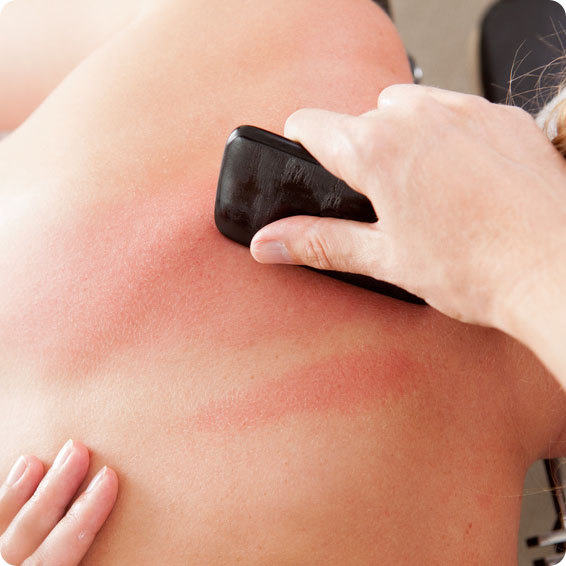
Some versions use tools to replace a therapist's hand, forearm etc. Many such methods use specially shaped fascial releasing tools. Such techniques broadly fit under the heading Instrument Assisted Soft Tissue Mobilisation (IASTM) these days. There are also many patented and trademarked versions of such methods, including Graston Technique ®. That said, just because something is trademarked or patented does not necessarily mean that it is better than other treatment methods. Trademarks and Patents are more about protecting intellectual property and financial interests. Although the broad term IASTM is relatively new, many techniques have similarities to ancient treatment methods like Gua Sha. Most IASTM techniques involve some form of friction massage, with variations between methods. Tools also exist for self-treatment or (SMFR), such as foam rollers, massage balls, massage sticks etc. (see the related SMFR articles further down).
Muscle Energy Techniques (METs) are a form of fascial releasing technique that can produce good results in the right circumstances. Although METs do use protocols, the methods are not patented or trademarked. There are different protocols according to the condition under treatment and the technique employed. Employing the incorrect technique in the wrong circumstances can result in muscle cramping or spasms.
A more invasive and precise technique for treating myofascial trigger point pain is Trigger Point Needling, though some patients may not like the idea of needling. There is also some good evidence of the effectiveness of treating various conditions with such methods. A good practitioner should have training, knowledge and experience in various techniques and know-how and in what circumstances to apply each technique. Hence, if a technique is unsuitable for a patient, the practitioner can still achieve treatment goals using other techniques. Other less invasive evidence-based treatment options include ischemic compression techniques.
Positional Release Technique (PRT) involves a treatment protocol and is effectively a form of ischemic compression. When used correctly, this can prove highly effective at reducing fascial pain and spasms. However, similar to METs, if not used correctly, the method can result in muscle spasms. Techniques such as Acupressure, Neuromuscular Therapy (NMT) or technique and trigger point therapy work with trigger points (TrPs). NMT is also a form of ischemic compression technique and can work precisely with trigger points, much like needling methods. Cupping and acupuncture may also work directly with TrPs, depending on how the practitioner uses the techniques.
Myofascial Cupping is also a form of soft tissue therapy which involves placing small cups made of glass, plastic or silicone over the area of tissues under treatment. The method relies on creating a vacuum between the cup and the tissues under treatment. Traditionally practitioners created a vacuum under a glass cup with a flame, and some still use this method. Other methods involve using a vacuum pump to remove air from within a hard plastic cup via a one-way valve. Malleable cups made of silicone rubber can create a vacuum on their own. The tissues underneath the cup are pulled up within the cup and effectively stretched while the cup is in place. Practitioners often use multiple cups at the same time, and the level of the vacuum underneath the cups impacts the amount of soft tissue stretch. There is a tendency to leave cups in place for a time, though a practitioner may slide cups once they are in position. Myofascial Cuppingis yet another form of myofascial release, and like Soft Tissue Release, it is possible to perform cupping actively or passively. Functional release cupping is one such method, which requires active movement from the patient. Passive techniques rely purely on the practitioner applying techniques with little active patient participation.
What does it feel like when fascia releases?
There can be differences in what one feels and depending on the specific method, technique application and therapist's knowledge and experience. A common feeling with most techniques is a sensation of tension or pressure in and around the soft tissues under treatment, shortly followed by a softening. The actual releasing sensation often feels like a "melting feeling" as the pressure and tension melt away. Although there is often an element of discomfort with fascial work, the phrase "good pain" is often used by the patient. The experience and skill of how the therapist uses and applies a technique, rather than just the technique, can change what one feels. Seeing a regulated health professional does not guarantee good technique application or the best results. Often qualified professionals in non-regulated MSK and soft tissue therapy fields may have considerably more experience using fascial releasing techniques in practice. It is possible to perform any method poorly, and common examples include, Dry Needling, Active Release Technique (ART) ®and IASTM or Graston Technique ®. There can be large differences between professionals within the same field, so a bad experience with one does not mean the same is true of others. Likewise, a poor experience with one technique may relate more to the person performing it than the technique. People work differently for many reasons and so find a good MSK professional.
Can you do Myofascial release therapy on yourself?

It is essential to understand that the design of myofascial release tools is to substitute a trained therapist performing a specific treatment technique. Many such tools were initially designed for therapists to use on patients and reduce loads on the therapist's hands. One should understand that a trained fascial release therapist has training in anatomy, physiology, correct technique application and knowledge of when it is safe or unsafe (contraindicated) to use a particular method. However, the market for selling such products to therapists is pretty limited, unlike the mass market of the general public. One could say similar about the massage therapy guns that are now popular. As with any treatment technique, there is a time and a place for using different types of myofascial release tools. Sadly, anybody can call themselves an expert and post videos on social media of them performing self-myofascial release with little knowledge of basic anatomy, physiology or the technique. Some such videos show unsafe practices, which are likely to cause damage.
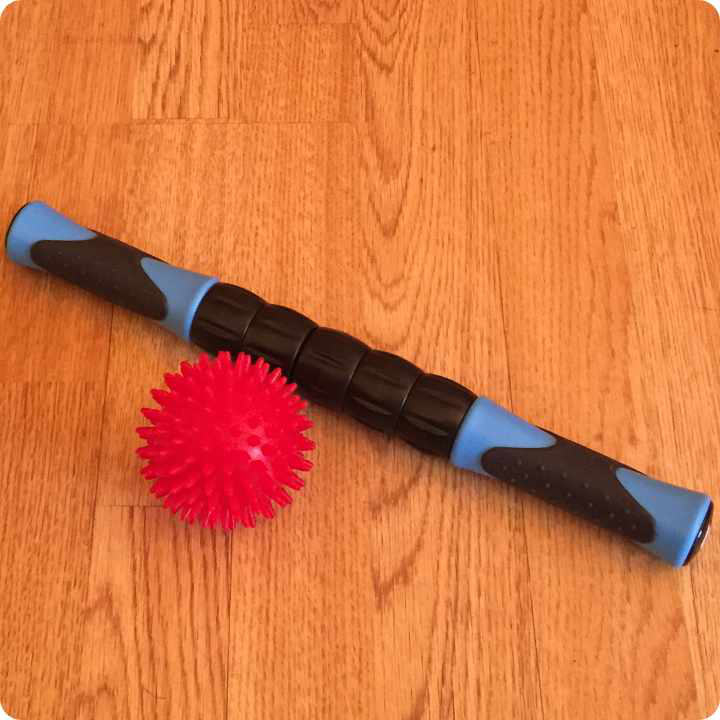
Self Myofascial release (SMFR) can be helpful in the right circumstances and work well as part of a self-maintenance routine. However, SMFR will never replace a good myofascial release therapist's skill, knowledge and experience. One can effectively perform Trigger Point Therapy (TPT) in a self-treatment context using tools such as a tennis ball, massage ball, squash ball or specific TPT tool (see the self Trigger Point Therapy article later). Other tools can prove helpful in petrissage-type myofascial release techniques (foam rollers, massage sticks, tennis balls, massage balls, squash balls). With the correct knowledge, it is possible to use a spiky massage ball in a self-soft tissue release (STR) context (see the article on Spiky Ball SMFR for legs). These techniques work differently and can work well when applied correctly and when tissues are in a suitable state to use the method. However, there is no "one tool fits all tool". Regardless of what people think, one cannot effectively treat the entire body with these tools. Tissues under treatment in a self-treatment context are usually not relaxed due to the mechanics of accessing tissues and applying a technique. Self-treatment also often involves twisting one's body to access tissues, which creates changes in tissue tension and affects biotensegrity (see related articles later)
Such changes in a self-treatment context affect the ability to apply techniques correctly and the state of the tissues under treatment. The internet is full of videos of people foam-rolling all kinds of muscles. The article on SMFR using Foam Rollers provides some useful pointers. It can be easy to bruise muscles or make symptoms far worse by using the wrong technique in the wrong circumstances. Self-maintenance is still advisable, but it is essential to understand the limitations of the tools, techniques and treatment in a self-treatment context (see the related article below). Even therapists need outside treatment help.
Self-Myofascial Releasing (SMFR) Treatment Techniques
- Foam Roller Myofascial Release (SMFR)
- Massage Ball Trigger Point Therapy (TPT)
- Massage Sticks - Quadriceps Legs (SMFR)
- Spiky Ball - Hamstrings legs (SMFR)
- SMFR leg routine using a massage stick and spiky ball on the legs.
References
- 1) Rate and maintenance of improvement of myofascial pain with dry needling alone vs. dry needling with intramuscular electrical stimulation:a randomized controlled trial.
- 2) Effects of dry needling of active trigger points in the scalene muscles in individuals with mechanical neck pain:a randomized clinical trial.
- 3) Effects of dry needling of active trigger points in the scalene muscles in individuals with mechanical neck pain:a randomized clinical trial.
- 4) Effects of dry needling of the obliquus capitis inferior on sensorimotor control and cervical mobility in people with neck pain:A double-blind, randomized sham-controlled trial.
- 5) Effects of pain neuroscience education and dry needling for the management of patients with chronic myofascial neck pain:a randomized clinical trial.
- 6) Dry Needling for the Treatment of Tension-Type, Cervicogenic, or Migraine Headaches:A Systematic Review and Meta-Analysis.
- 7) Effects of Dry Needling Technique Into Trigger Points of the Sternocleidomastoid Muscle in Migraine Headache:A Randomized Controlled Trial.
- 8) Effectiveness of dry needling for headache:A systematic review.
- 9) The effects of dry needling on pain relief and functional balance in patients with sub-chronic low back pain.
- 10) Short-term effects of two deep dry needling techniques on pressure pain thresholds and electromyographic amplitude of the lumbosacral multifidus in patients with low back pain - a randomized clinical trial.
- 11) The use of dry needling vs. corticosteroid injection to treat lateral epicondylitis:a prospective, randomized, controlled study.
- 12) Effects of trigger point dry needling on lateral epicondylalgia of musculoskeletal origin:a systematic review and meta-analysis.
- 13) Effects of Trigger Point Dry Needling for Nontraumatic Shoulder Pain of Musculoskeletal Origin:A Systematic Review and Meta-Analysis.
- 14) The Long-Term Effectiveness of Trigger Point Dry Needling and Exercise for Individuals With Shoulder Pain:A Critically Appraised Topic.
- 15) Changes in Muscle Tone, Function, and Pain in the Chronic Hemiparetic Shoulder after Dry Needling Within or Outside Trigger Points in Stroke Patients:A Crossover Randomized Clinical Trial.
- 16) Effectiveness of Dry Needling Therapy on Pain, Hip Muscle Strength, and Physical Function in Patients With Hip Osteoarthritis:A Randomized Controlled Trial.
- 17) Effects of dry needling on pain, pressure pain threshold and psychological distress in patients with mild to moderate hip osteoarthritis:Secondary analysis of a randomized controlled trial.
- 18) Effects of dry needling in HIP muscles in patients with HIP osteoarthritis:A randomized controlled trial.
- 19) Effects of Trigger Point Dry Needling on Neuromuscular Performance and Pain of Individuals Affected by Patellofemoral Pain:A Randomized Controlled Trial.
- 20) Added Value of Gluteus Medius and Quadratus Lumborum Dry Needling in Improving Knee Pain and Function in Female Athletes With Patellofemoral Pain Syndrome:A Randomized Clinical Trial.
- 21) The Effect of Dry Needling on Pain, Range of Motion of Ankle Joint, and Ultrasonographic Changes of Plantar Fascia in Patients With Plantar Fasciitis.
- 22) Preliminary Report on the Role of Dry Needling Versus Corticosteroid Injection, an Effective Treatment Method for Plantar Fasciitis:A Randomized Controlled Trial.
- 23) Efficacy of dry needling in patients with myofascial temporomandibular disorders related to the masseter muscle.
- 24) Dry needling versus trigger point compression of the upper trapezius:a randomized clinical trial with two-week and three-month follow-up.
- 25) Effectiveness between Dry Needling and Ischemic Compression in the Triceps Surae Latent Myofascial Trigger Points of Triathletes on Pressure Pain Threshold and Thermography:A Single Blinded Randomized Clinical Trial.
- 26) A sonographic comparison of the effect of dry needling and ischemic compression on the active trigger point of the sternocleidomastoid muscle associated with cervicogenic headache:A randomized trial.
- 27) Comparison of dry needling and ischaemic compression techniques on pain and function in patients with patellofemoral pain syndrome:a randomised clinical trial.
- 28) Evidence for the Use of Ischemic Compression and Dry Needling in the Management of Trigger Points of the Upper Trapezius in Patients with Neck Pain:A Systematic Review.
- 29) Discrepancy between prevalence and perceived effectiveness of treatment methods in myofascial pain syndrome:Results of a cross-sectional, nationwide survey.
- 30) Comparison of dry needling and trigger point manual therapy in patients with neck and upper back myofascial pain syndrome:a systematic review and meta-analysis.
- 31) Effectiveness of Traditional Chinese “Gua Sha” Therapy in Patients with Chronic Neck Pain:A Randomized Controlled Trial.
- 32) The effects of Gua sha on symptoms and inflammatory biomarkers associated with chronic low back pain:A randomized active-controlled crossover pilot study in elderly.
- 33) The Effect of Gua Sha Treatment on the Microcirculation of Surface Tissue:A Pilot Study in Healthy Subjects.
Massage and Myotherapy Registrations
Terry brings over 16 years of experience treating in the MSK Therapy field back to Brisbane from the UK. He is highly qualified with relevant education and training spanning from Certificate level through to higher education and a Masters. His training and experience cover many assessment methods, treatment types and soft tissue therapy (STT) skills. Besides the sixteen years of clinical experience, Terry has a further eight years of experience training and working at the highest physical performance levels within the elite British forces environment. He has a personal experience with a range of running injuries and a vast amount of professional treatment experience. He is still an avid distance runner to this day. Such knowledge has proved highly valuable in the treatment of elite-level athletes and members of the public. His ongoing sporting activities, experiences and interests have naturally led to him specialising in human performance and treating trauma and myofascial pain. He also taught as a senior course coach on the first myotherapy course in Brisbane. His skills are now available at the Morningside clinic, where he works as a Myotherapist.